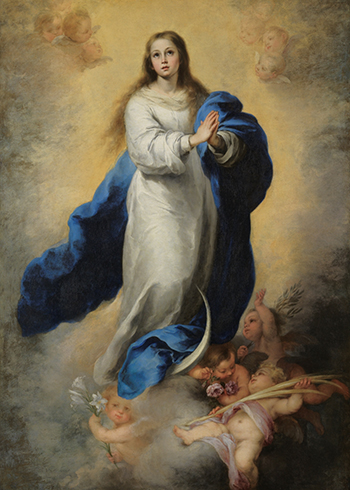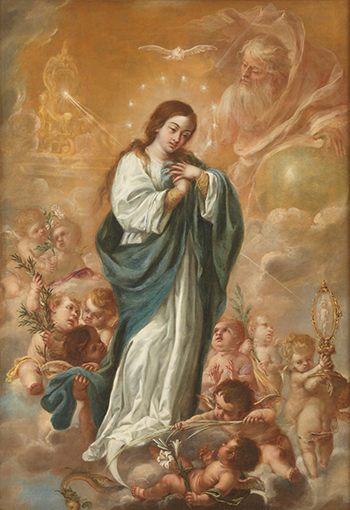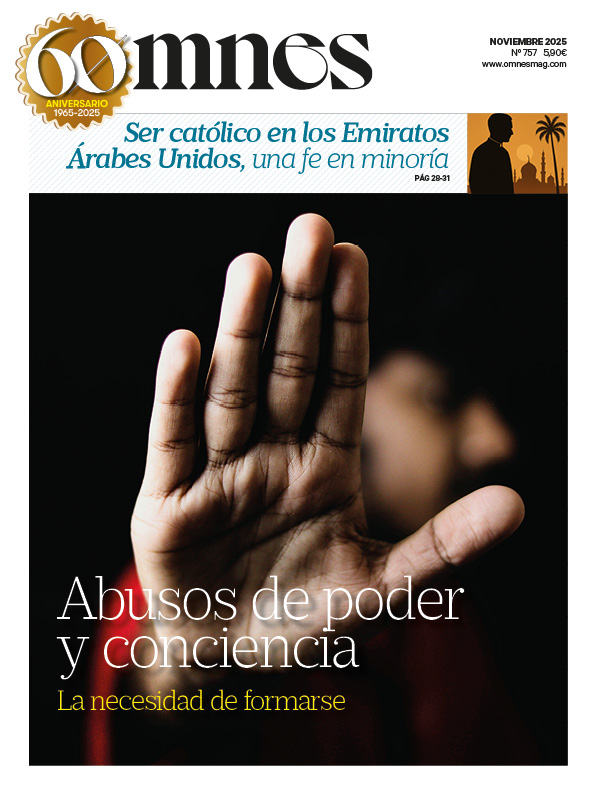There have been numerous writings, studies and apologetics that, especially since the 14th century, have been developed around this dogma of faith that defends the virginal conception of Mary: the preservation of original sin, already from her conception in her mother's womb, to the one who would be the Mother of God.
Immaculate Conception from the beginning of faith
Already in Genesis, we find one of the foundations, which would later be wonderfully captured in artistic allegories, of this preservation of Mary from original sin: "I put hostility between you and the woman, between your offspring and her offspring; she will crush your head when you strike her heel".
In the New Testament, the Gospel of St. Luke records how the angel calls to Mary "full of grace"i.e, "who is not in possession of sin". Although already since the first centuries of our faith some Greek and Latin church fathers refer to Mother God as "immaculate"The first news about the celebration of this feast dates back to the 7th century, in several monasteries in Palestine, for example, St. Justin or St. Irenaeus.
The conviction of the virginal conception of Holy Mary has accompanied the Christian people since the beginning of the faith. The proclamation of Mary as the Mother of God at the Council of Ephesus against the Nestorian heresy, in some way, although not explicitly, reflected this conviction.
Although the definition of the dogma in the Catholic Church will take time to arrive, already in the thirteenth and fourteenth centuries the immaculist question takes a central place in the writings of the faith with figures such as Blessed John Duns Scotus. Pius IX himself in "Ineffabilis Deus", the apostolic letter in which he declared the Dogma of the Immaculate Conception, recalls this sentiment of the faithful, emphasizing how "from the earliest times, prelates, ecclesiastics, religious orders, and even emperors and kings themselves, earnestly begged this Apostolic See to define the Immaculate Conception of the Most Holy Mother of God as a dogma of Catholic faith".
Spain was, from very early on, a nation with a clear immaculist sentiment: popular fervor gave birth, from very early on, to the first feasts and artistic manifestations that reflect this fervor for the Mother of God and her Immaculate Conception.
In Spain, as early as the seventh century, the Feast of the Immaculate Conception. A large number of medieval liturgical texts show that the feast of the Immaculate Conception was kept in the thirteenth century, increased its popularity in the fourteenth century and spread widely throughout Spain during the fifteenth century, especially after the recovery of the territories of southern Spain by the crown of Castile. In the 16th century we witnessed a proliferation of confraternities that were placed under the invocation of the Pure and Clean Conception of Mary.
During these years, there were many embassies that Spanish monarchs, ecclesiastics and nobles presented to the Pope, asking for a formal declaration of what was a universal feeling among the Catholic people. Although the Dogma would still have to wait, the successive Popes endorsed, in an indirect way, the immaculist doctrine, sponsoring and promoting this devotion throughout Europe and the Spanish-American territories.
The peak of the immaculist fervor would be the 17th century, a time when we find examples of a very strong and widespread devotion to the Immaculate Conception with such notable examples as Valladolid or Seville, whose city and clergy stood as an example of this Marian fervor, multiplying, by then, liturgical feasts, associations and brotherhoods and, therefore, the artistic manifestations in painting, sculpture and dedications of temples to the Immaculate Conception. Huelva, belonging to the diocesan territory of Seville, would be the first city in Spain to dedicate a temple to the Immaculate Conception.
In these years there are many known as Immaculate vowsThe University of Toledo, for example, made such a vow on December 10, 1617, to be followed by universities as important as Salamanca (which played an important role in the petition to the Pope for the definition of the dogma of the Immaculate Conception), Granada or Valladolid. Along with these university vows, cities, some religious orders and even certain Hispanic dioceses, made this vow of defense of the immaculist doctrine that would translate into new petitions to Rome in favor of this dogma.
The eighteenth and nineteenth centuries will experience moments of ups and downs in the expansion and strength of devotion to Our Lady in the mystery of the Immaculate Conception.
The influence of French ideas, the wars and invasions suffered in Spain caused problems for many corporations, brotherhoods and religious congregations. Although Charles II, with the approval of Clement XIII, declared in 1760 to the Immaculate Virgin Patron Saint of Spain and all its possessions and in 1800, extended to all universities in Spain the obligation to swear the oath of defense of the Immaculate Conception.
Half a century later, the dogmatic definition of the Immaculate Conception in 1854, and the apparitions of Our Lady to St. Bernadette Soubirous under this name, would lead to an explosion of fervor for the Immaculate Conception in the 19th century throughout the Catholic world.
In 1857, the famous monument to the Immaculate Conception in Piazza di Spagna in Rome. The image, the work of Luigi PolettiThe column, which is 12 meters high, is crowned by a column. Roman firefighters hoisted the column and the image of Our Lady. Hence the annual tradition in which the firefighters of Rome place a bouquet on top of the column every December 8.
Despite the advance of secularism and the tumultuous years of the late 19th and 20th centuries, devotion to the Immaculate Conception continued to be promoted by the Catholic Church and was one of the dogmas with the greatest attention to modern Marian documentation and theology as can be seen in Mary, Mother of the Redeemer, by J.L Bastero.
The Immaculate Conception in art

The first formulas to represent that the Virgin Mary had been conceived free of original sin from the first moment of her Conception were based on the passages of her childhood, narrated in various apocryphal books, and which showed the story of her parents, Joachim and Anne, by means of narrative images such as the chaste embrace, or kiss, before the Golden Gate.
In addition to these narrative types, other images of a conceptual nature were added, such as the types of Santa Ana triple or the Jesse tree. However, it would be the "Tota Pulchra"The representative line inherited from the Middle Ages, which would settle and develop in sculptural and pictorial iconography.
On a regular basis, Francisco Pacheco (1564-1644) is considered the master of immaculist iconography. Although the motif was also treated by other artists such as Francisco Herrera el Viejo who painted a Virgin of the Immaculate Conception in which most of the images alluding to the purity of Mary are located in the lower landscape.
In his work Art of PaintingPacheco dictated the master lines for the representation of the Immaculate that we find in his works: a young woman dressed in white tunic and blue cloak, symbols of purity and eternity respectively, crowned with twelve stars (stellarium), the crescent moon downward and a snake at her feet symbolizing her dominion over sin. The figure of the Virgin would have been surrounded by an oval glow of golden tones.
The influence of this representative line is evident in other artists such as Zurbarán and, with slight variations by his son-in-law, Velázquez and other painters such as Ribera or later, Goya himself.
However, it would be Bartolomé Esteban Murillo who, in the field of painting, would stand out in this field with a work of more than twenty paintings of the Immaculate Conception.
The devotion to the Immaculate Conception has been captured, especially since the 17th century, by numerous artists from all over the world, being, in addition to works of devotion, true plastic catechesis.
Symbology of the Immaculate Conception
The symbols collected in the painting or in the carvings of these images of the Immaculate Conception, serve, to all Catholics, as a reminder and recognition of truths of faith, biblical passages, invocations of the litanies of Laurel and Marian glories. Over time, these symbols vary in their presence and importance in artistic representations, although those referring to the age of the Virgin and the color of her vestments remain constant.
- The young woman: The Immaculate is always young, pure, from birth. She is represented at an age identifiable with the moment of the Annunciation, which links the purity of her conception with the divine conception of Jesus Christ. Before, during and after childbirth, Mary is spotless, possessing the eternal youth of her soul.
- White garments: They represent total purity, unstained by sin.
- Celestial mantle: Along with the white vestments, very soon, the Immaculate begins to be represented wrapped in a celestial mantle that reflects both the color of heaven - the divinity - that covers Mary, recalling the words of the angel at the Annunciation.
- Los Angeles: The image of the Virgin appears next to one or more cherub heads representing all the angels, the celestial army that welcomes and is below a single creature: the Virgin.
- The snake: In many sculptural and pictorial motifs, the serpent appears under the feet of the Virgin, representing the curse to the devil and the promise of salvation made by God in Genesis "The Lord God said to the serpent: "Because you have done this, cursed are you among all the cattle and all the beasts of the field; you will crawl on your belly and eat dust all your life; I put hostility between you and the woman, between your offspring and her offspring; it will crush your head when you strike it on the heel".
- The moon: This star is one of the most iconic in the representation of the Immaculate Conception. The moon, symbol of chastity, allows the light of the sun to pass through it, just as the power of God passes through the Virgin without staining her, without hurting her... Pacheco painted the moon with its points downward, crystallizing a pictorial option that was widely used from that moment on.
- El Sol: Pacheco himself pointed out that the image of the Immaculate Conception had to be surrounded by a composition in aurea tones.
- The door: Remember the Marian mediation: The Virgin is the Heaven's Gate through which the Savior becomes incarnate and enters our home and, at the same time, is the door that leads us to Him.
- The boat: Many of the images of the Immaculate Conception are accompanied by a ship on the sea in allusion to the medieval hymn Ave Maris Stella, the Virgin as star of the sea and also as a safe harbor.
- The mirror: One of the symbols that sometimes accompanies the Immaculate Conception is a mirror, often held by an angel. "Mirror of Justice," is one of the invocations of the Lauretan Litany that reminds us that Mary reflects the beauty and power of God.
- The fountain or well: The representation of a fountain in the images of the Immaculate Conception refers to the famous Song of Songs, in which the image of the fountain, center of life and purification as well as an example of crystalline beauty, is frequently used.

- The palm tree: Although the image of the palm tree will cease to be used with the passage of time, this tree recalls, on the one hand, the lost paradise. But also the refuge of travelers and justice.
- Flowers: The rose, symbol of perfect love, is translated into the Rosa mistica, one of the invocations of the litanies most used in art. In fact, Rosary means crown of roses, in which each Hail Mary means a rose brought to the Virgin.
In addition to the rose, it is common to unite the Immaculate with lilies and other flowers, such as lilies, which symbolize purity, because of their white color and perfume, as well as the beauty of Mary, God's most perfect creation.
Some experts point out that the representation of the petals open upwards indicates openness to God. When they open to the sides, they allude to generous maternity, mother of all men. If all the petals form a single lily, it represents the fraternity and union of all the children of God the Father.
- Throne of wisdom: In some pictorial representations of the Immaculate Conception we find this allusion to this Marian invocation, which also recalls the important role of the universities in the development of this devotion.
- The Ark of the Covenant was the most sacred treasure of the Israelite people. It contained the Tablets of the Law, the manna urn and Aaron's rod. Not in vain, the new covenant is Christ and it was Mary's womb that guarded this new covenant.
- The staircase: Some authors point to the ladder as another symbol of Marian mediation, the Virgin leading humanity to her Son, to heaven.








